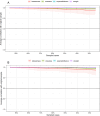Depressive symptoms and internet use among middle-aged and older adults pre- and post-COVID-19 outbreak: a network analysis
- PMID: 40676656
- PMCID: PMC12273029
- DOI: 10.1186/s40359-025-03119-8
Depressive symptoms and internet use among middle-aged and older adults pre- and post-COVID-19 outbreak: a network analysis
Abstract
Background: The COVID-19 pandemic exacerbates the effects of social isolation on the mental health of middle-aged and older adults. This study aimed to explore the network structures of depressive symptoms among Chinese middle-aged and older adults before and after the COVID-19 outbreak and investigate their associations with Internet use.
Methods: Two cross-sectional datasets were obtained from the 2018 and 2020 waves of the China Health and Retirement Longitudinal Study (CHARLS). Depressive symptoms and Internet use were assessed using the Center for Epidemiological Studies-Depression Scale (CES-D) and self-reported Internet use. Network analysis was conducted to identify central symptoms and differences between the two networks and their associations with Internet use.
Results: Network analysis revealed that CESD3 "Felt depressed" was the central symptom of the depression network in both waves. No significant differences in network structure were observed, but significant differences in global strength and edge strength were found. Furthermore, Internet use showed a more complex association with depressive symptoms among middle-aged and older adults in wave 2.
Conclusion: This study provides novel insights into the central features of depressive symptoms among middle-aged and older adults before and after the COVID-19 outbreak. Targeting interventions to central symptoms and strong edges may have significant implications for depression treatment. In addition, strategies aimed at enhancing Internet use guidance could potentially benefit the mental health of middle-aged and older adults.
Keywords: COVID-19; Depressive symptoms; Internet use; Middle-aged and older adults; Network analysis.
© 2025. The Author(s).
Conflict of interest statement
Declarations. Ethics approval and consent to participate: This study was performed in accordance with the Declaration of Helsinki. Ethics approval was obtained from the Biomedical Ethics Review Committee of Peking University (approval number: IRB00001052-11015). Informed consent was obtained from all participants involved in the study. Consent for publication: Not applicable. Competing interests: The authors declare no competing interests.
Figures




Similar articles
-
The association between hearing loss and depression in the China health and retirement longitudinal study.Sci Rep. 2025 Jul 1;15(1):20537. doi: 10.1038/s41598-025-05749-9. Sci Rep. 2025. PMID: 40595946 Free PMC article.
-
Longitudinal Dyadic Associations Between Internet Use and Mental Health Among Middle-Aged and Older Chinese Couples: An Actor-Partner Interdependence Approach.J Gerontol B Psychol Sci Soc Sci. 2025 Jun 10;80(7):gbaf097. doi: 10.1093/geronb/gbaf097. J Gerontol B Psychol Sci Soc Sci. 2025. PMID: 40411491
-
Core Symptoms and Dynamic Interactions of Depressive Symptoms in Older Chinese Adults: A Longitudinal Network Analysis.Depress Anxiety. 2025 Jul 23;2025:8078557. doi: 10.1155/da/8078557. eCollection 2025. Depress Anxiety. 2025. PMID: 40740343 Free PMC article.
-
The effectiveness of nonpharmacological interventions in older adults with depressive disorders: a systematic review.JBI Database System Rev Implement Rep. 2015 Jul 17;13(6):220-78. doi: 10.11124/jbisrir-2015-1718. JBI Database System Rev Implement Rep. 2015. PMID: 26455753
-
Technological aids for the rehabilitation of memory and executive functioning in children and adolescents with acquired brain injury.Cochrane Database Syst Rev. 2016 Jul 1;7(7):CD011020. doi: 10.1002/14651858.CD011020.pub2. Cochrane Database Syst Rev. 2016. PMID: 27364851 Free PMC article.
References
MeSH terms
Grants and funding
LinkOut - more resources
Full Text Sources
Medical

